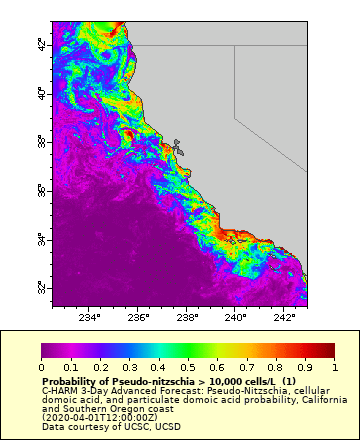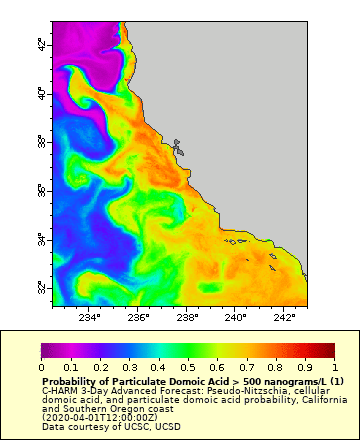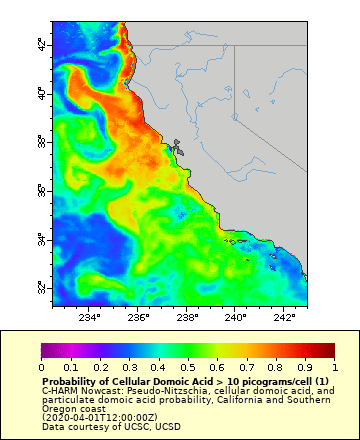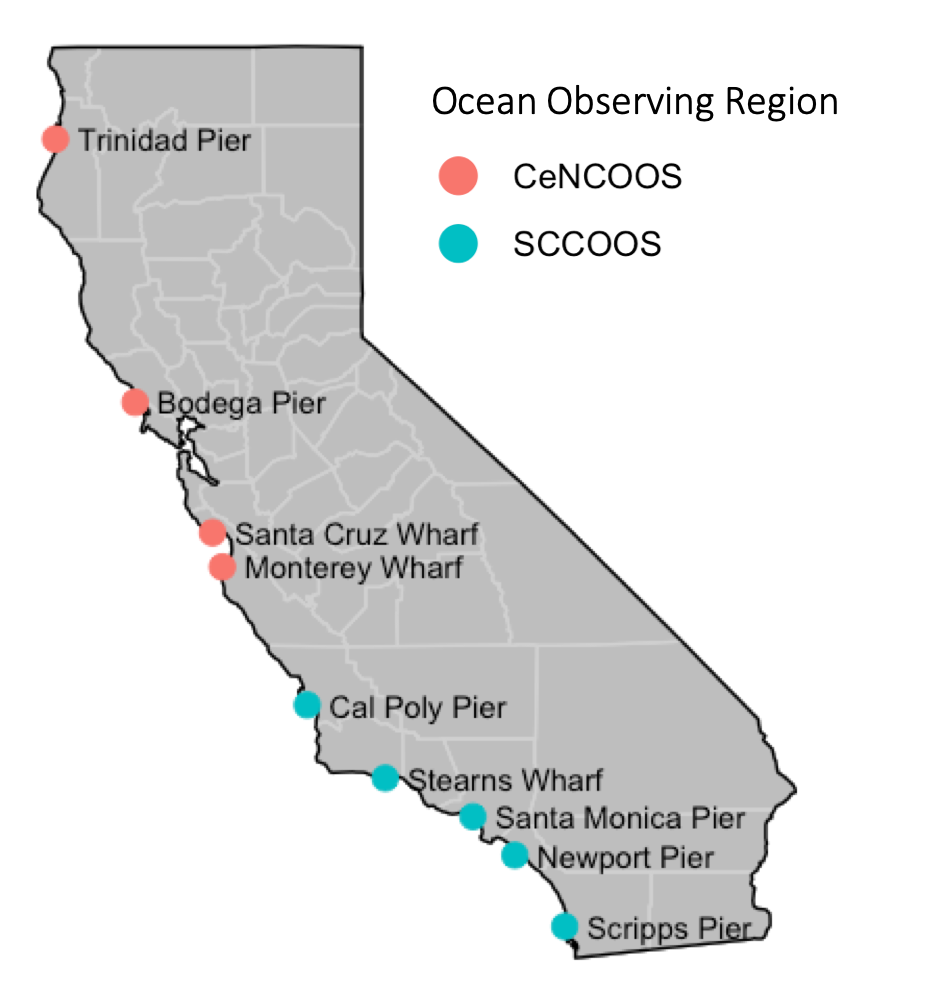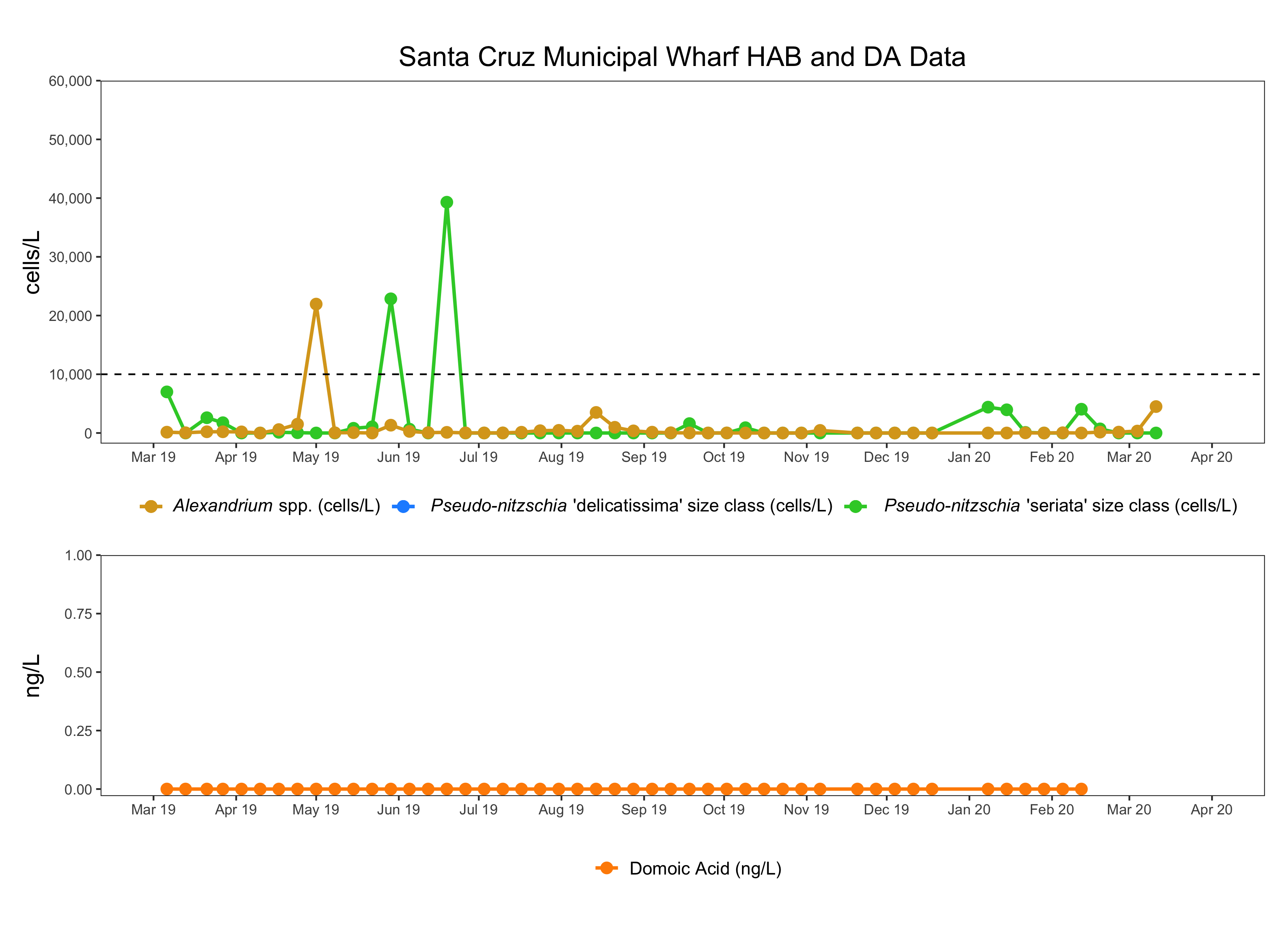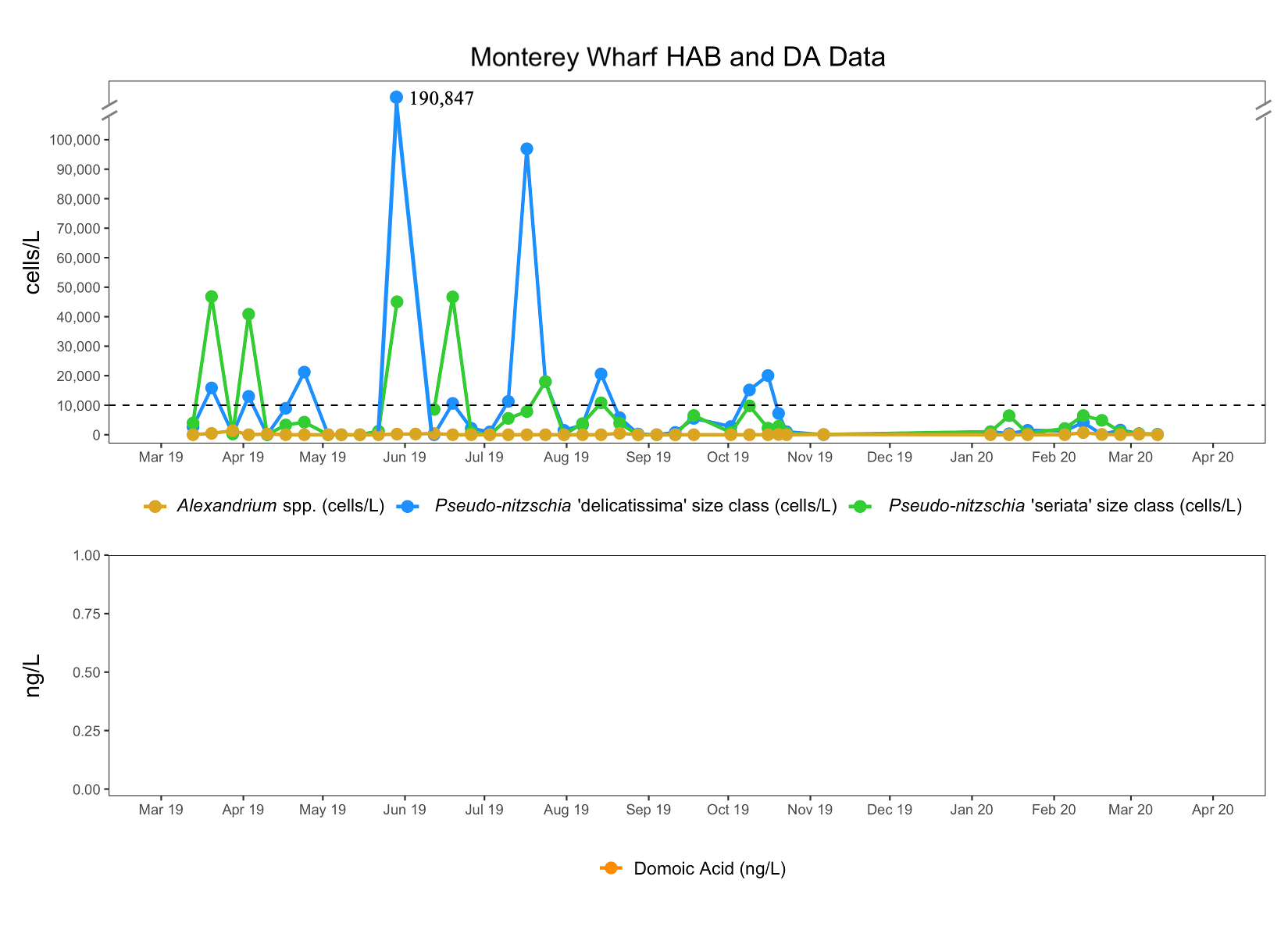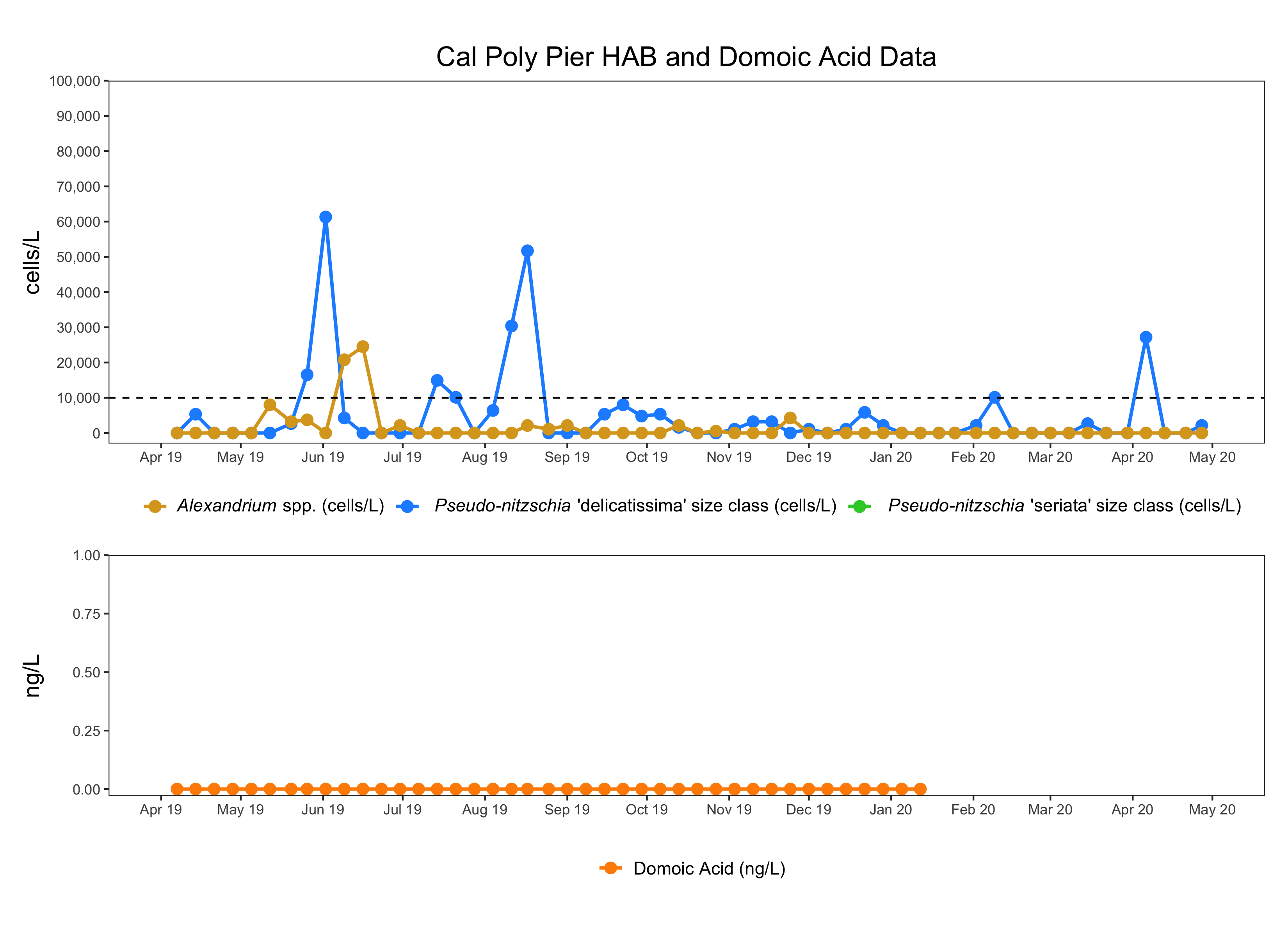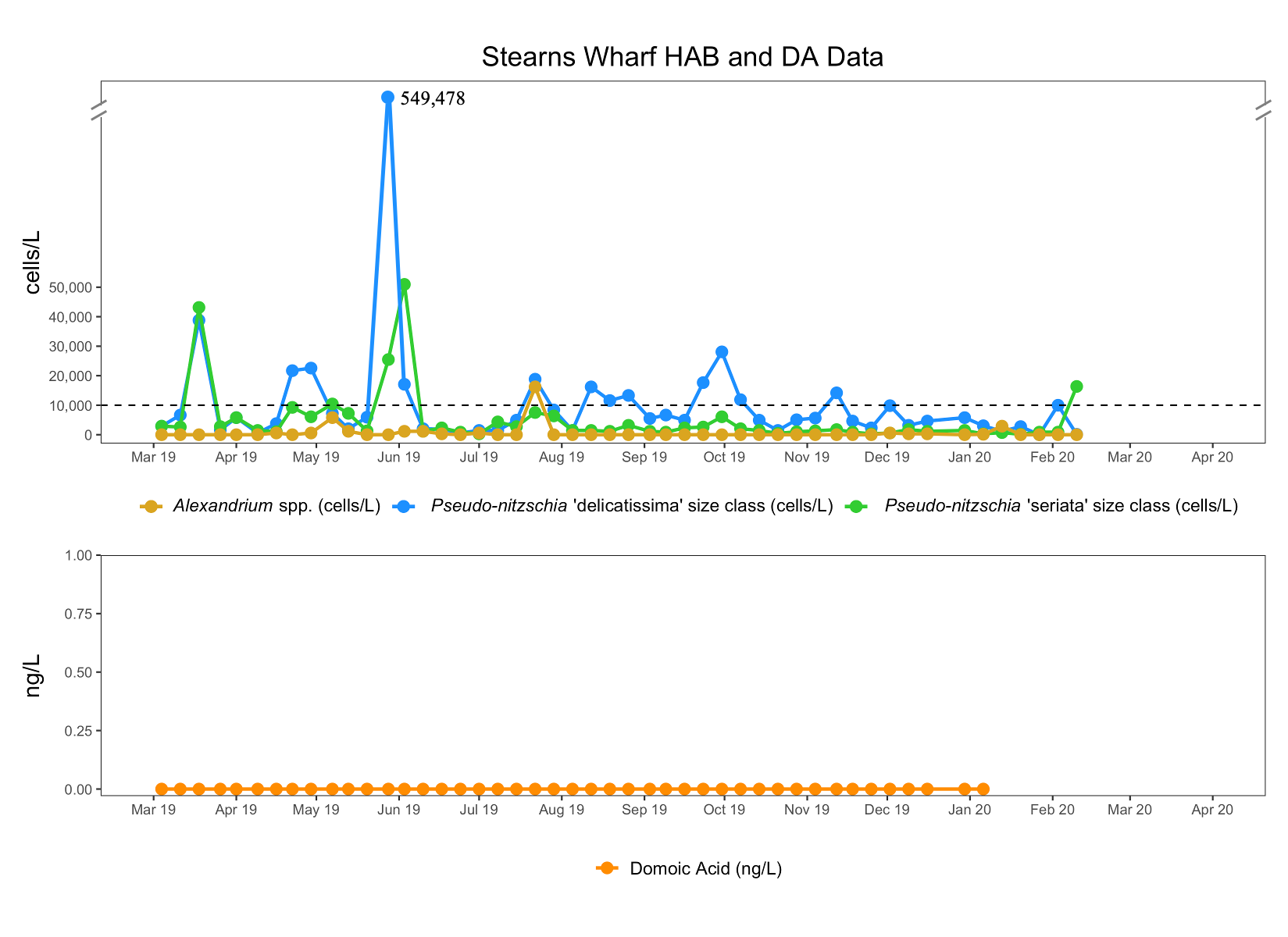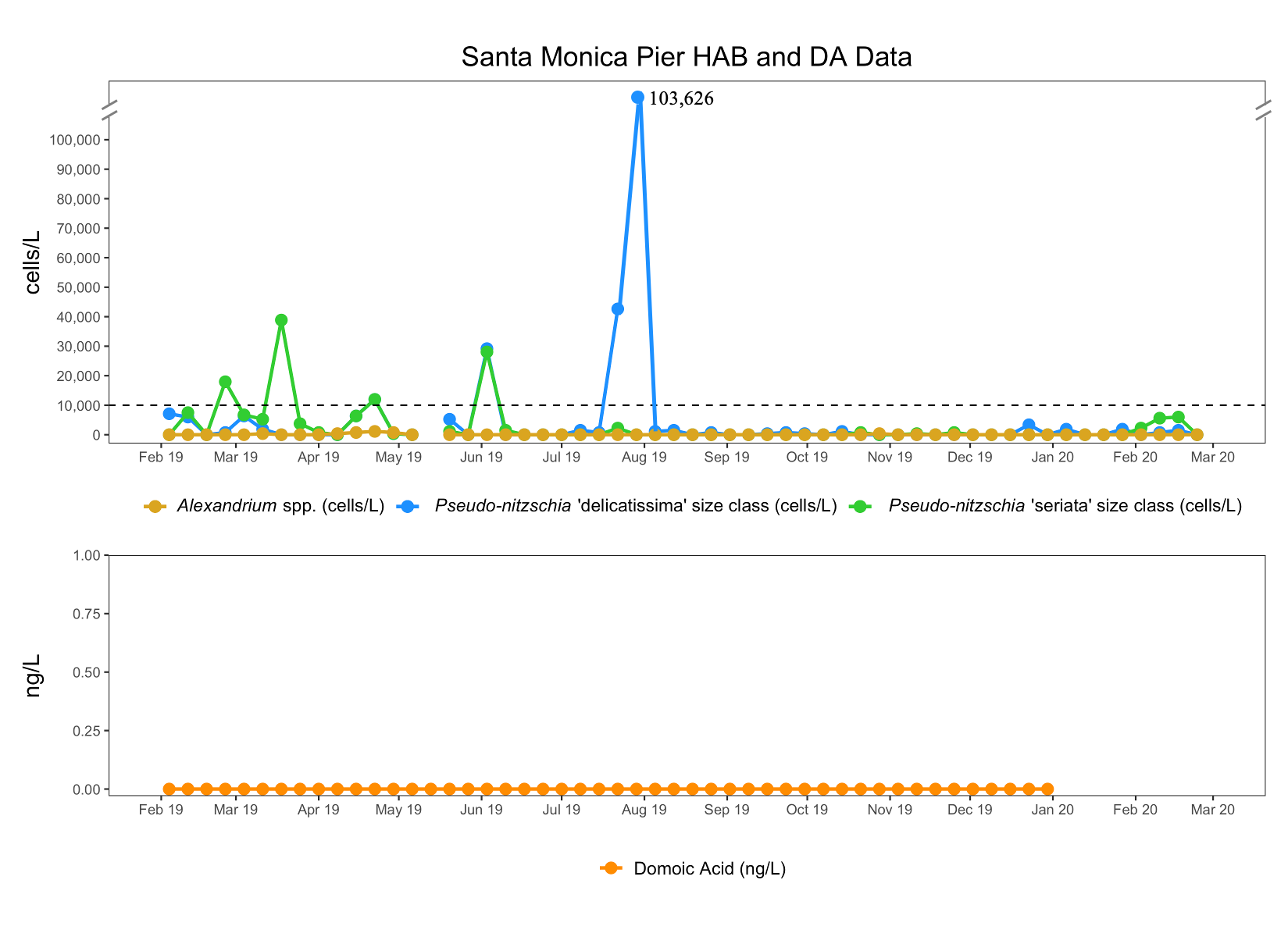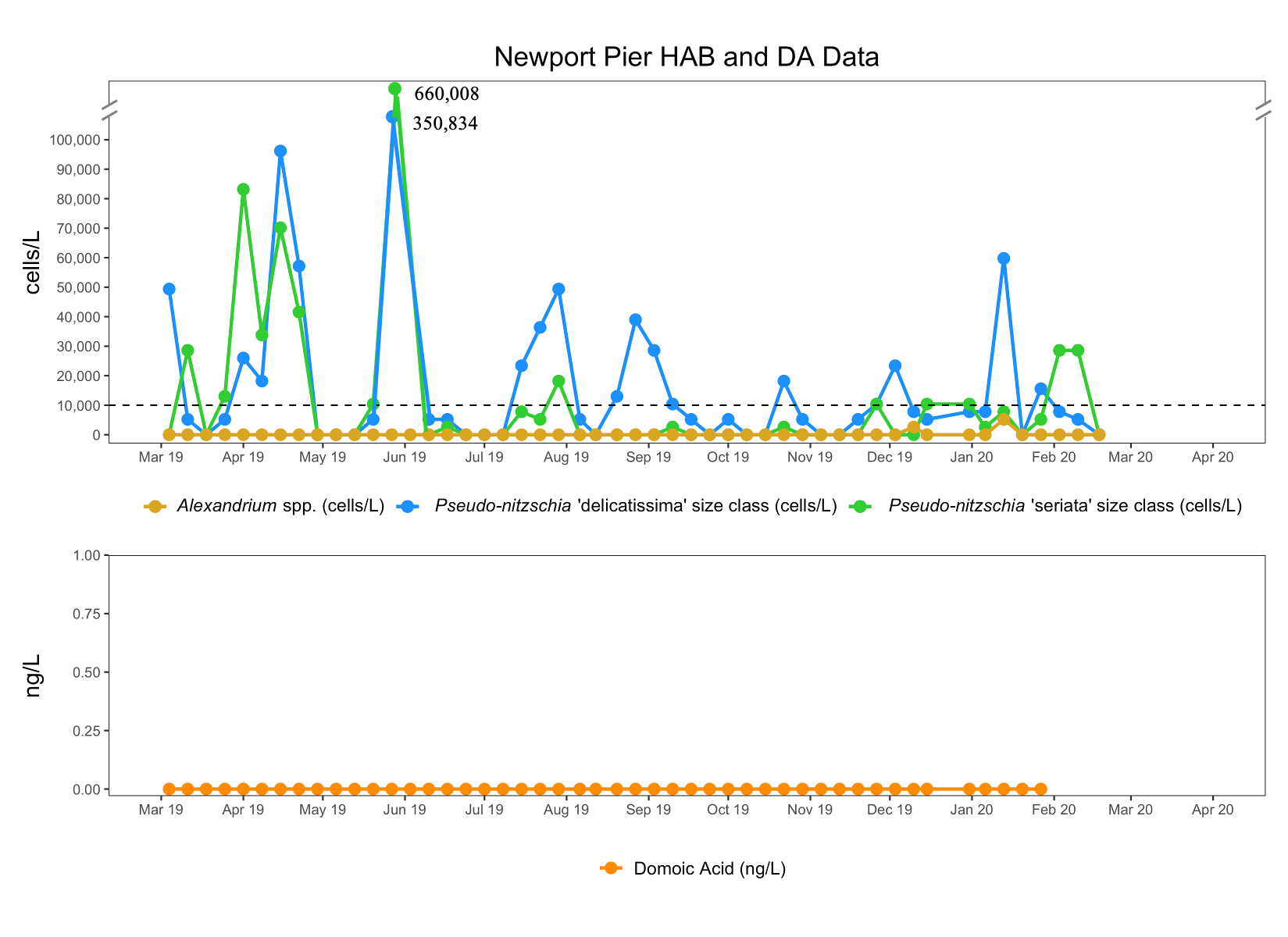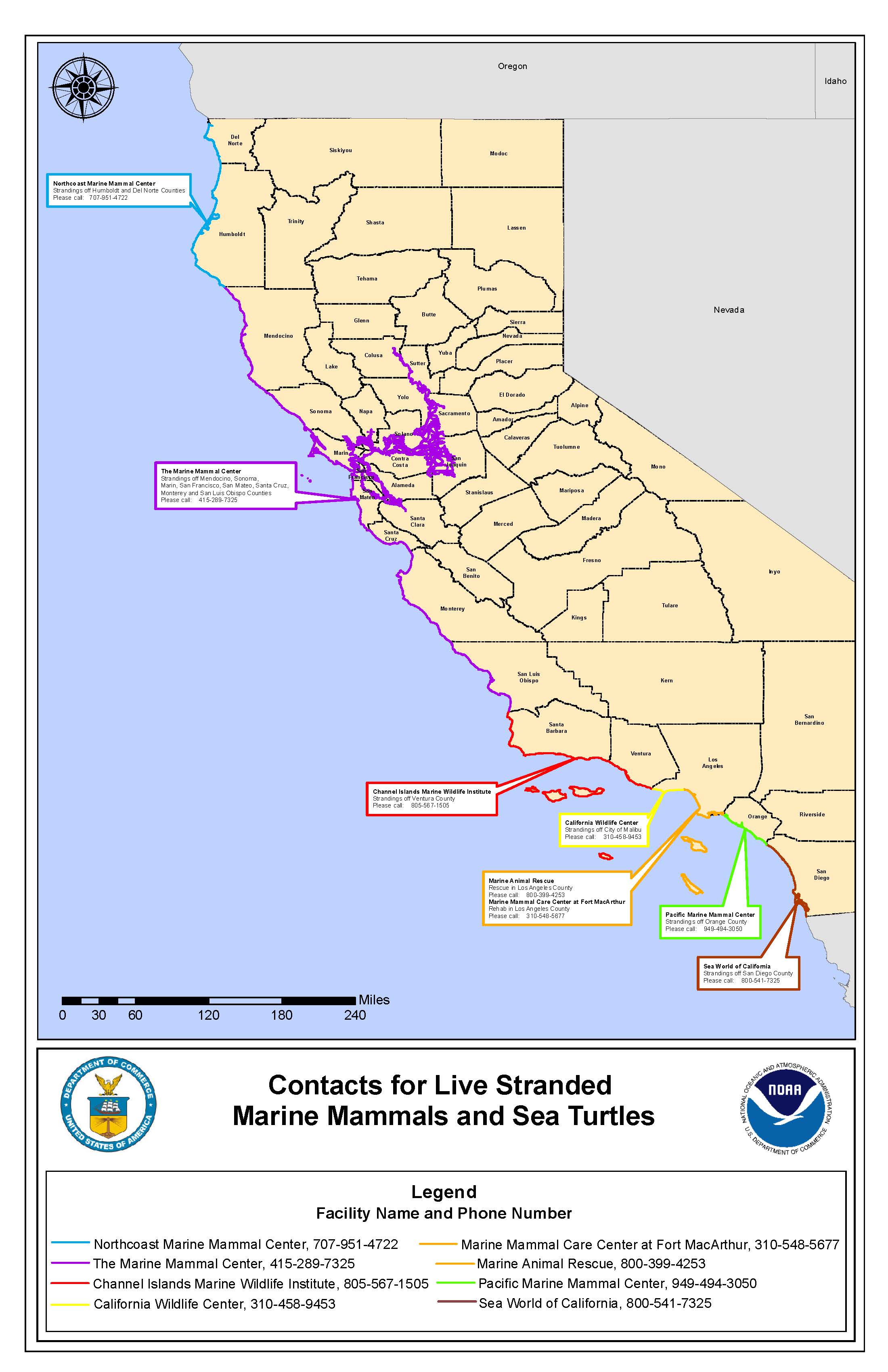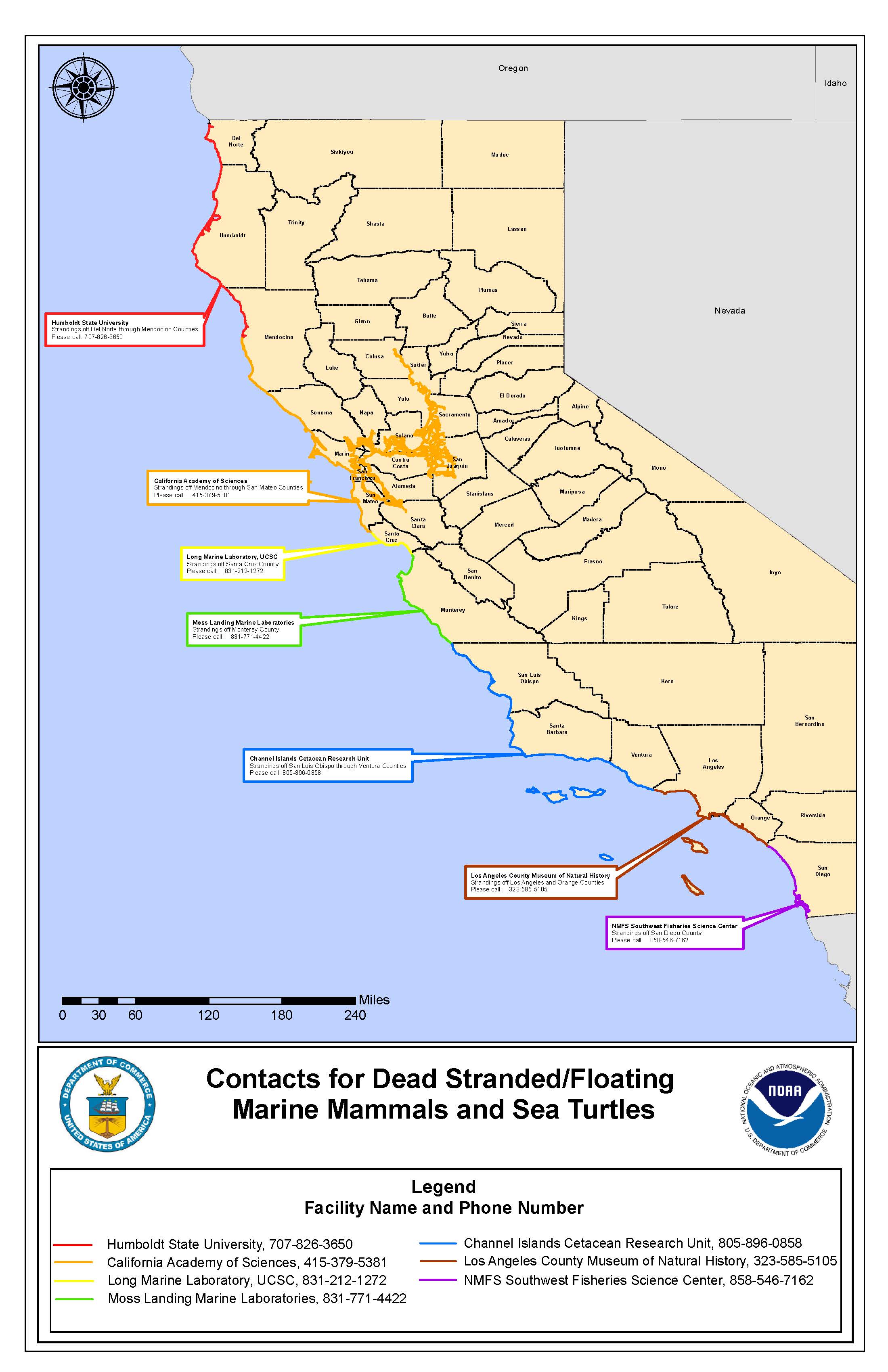Be sure to also read the special Red Tide Bulletin: Spring 2020
Pseudo-nitzschia - C-HARM tells us where conditions are suitable for species of the diatom Pseudo-nitzschia spp. (all size classes) to grow well and where they might be more likely to produce domoic acid (DA). Predicted suitable habitat for Pseudo-nitzschia spp. was spread around throughout coastal California in April, much like in previous months. There were periods of contraction towards the coast mid-month, flanked by offshore probabilities that were very high and often followed what appear to be eddy contours. Bloom probabilities in the Southern California Bight started off low but increased throughout the month, particularly in the nearshore zone. While we do not have much in the way of HABMAP cell counts in April due to COVID-19 sampling restrictions, we do know that the Pseudo-nitzschia "delicatissima" size class bloomed in early April at Cal Poly Pier. We also know that a massive red tide pervaded the region from the Santa Barbara Channel to Baja from March to May and could account for elevated chlorophyll or high remote sensing reflectance in this area during April, perhaps leading to false positives in the Pseudo-nitzschia bloom model. It should also be noted, however, that robotic microscope (IFCB) data presented in the Red Tide Bulletin showed fairly elevated abundance of Pseuodo-nitzschia spp. in shelf waters as the bloom was starting.
Most of the activity for particulate DA (pDA) was predicted for central and northern California, with the Humboldt and Mendocino coasts waxing and waning in terms of intensity throughout the month of April. Probabilities off the coast of the San Francisco/Bay Area and the Monterey Bay were fairly consistently high for pDA where three California Sea Lions and one Guadalupe Fur Seal were reported stranded due to suspected DA toxicosis by The Marine Mammal Center (TMMC). The Southern California Bight saw elevated pDA probabilities that mostly remained offshore but occasionally grew intense in the Santa Barbara Channel, Los Angeles, and San Diego regions, consistent with two possible DA toxicosis cases from the Pacific Marine Mammal Center (PMMC) and one possible DA toxicosis case from the Marine Mammal Care Center Los Angeles (MMCC-LA). C-HARM predicted high cDA probabilities for the central and northern coasts, Pt. Conception to Humboldt, for high cellular DA (cDA) levels with a broad offshore extent, similar to March. probabilities for cDA were even lower in the Southern California Bight than in March, and in contrast to the pDA predictions. This may suggest that there was not a lot of active DA production in the Bight (south of the SBC) overall during April.
CDPH recorded that Pseudo-nitzschia "seriata" was common near Drakes Bay and Tomales Bay (Marin County) and Diablo Cove (central coast, SLO County) and present at many other sites from San Diego to Humboldt counties, consistent with C-HARM.
Alexandrium - CDPH noted that Alexandrium spp. were present but a low abundance in Agua Hedionda Lagoon in Carlsbad (San Diego County) and in Humboldt Bay.
**Please note that HABMAP sampling, CDPH sampling and marine mammal rescues have been greatly reduced in response to COVID-19 safety measures.
**HABMAP sampling has been suspended since March 19th in accordance with the Governor's stay at home order to protect the health and well-being of all Californians and to help slow the spread of COVID-19. Cal Poly and Scripps received an exception to continue collecting water samples for the State and are taking the necessary safety measures to protect field personnel. The water samples are being preserved for future analysis by the Caron or Kudela Labs for domoic acid and Brzezinski/UCSB Marine Analytical Labs for macronutrients when it is safe for lab personnel to do so.**
Note that data for some stations are not shown because they are not yet recorded in the public HABMAP archive.
Differentiating Pseudo-nitzschia species by light microscopy is difficult. For this reason, Pseudo-nitzschia "seriata" does not refer to an actual species but rather the larger size class of Pseudo-nitzschia, which is generally a more toxigenic group of species. Alternatively, Pseudo-nitzschia "delicatissima" refers to the smaller size class that is generally non-toxigenic. The dashed line on the plots demarcates the 10,000 cells/L "bloom" threshold designated here for Pseudo-nitzschia populations only.
More information and data visualizations on the statewide HAB network and forecasting system can be found here and on the SCCOOS HABMAP page.
Santa Cruz Wharf
Water samples were not collected at Santa Cruz Wharf in the month of April.
The Santa Cruz Wharf shore station is supported by CeNCOOS PI Raphael Kudela at UCSC.
Monterey Wharf
Water samples were not collected at Monterey Wharf in the month of April.
Monterey Wharf shore station is supported by CeNCOOS PI's Raphael Kudela at USCS and Jason Smith and Moss Landing Marine Labs.
Cal Poly Pier
Water samples at Cal Poly Pier were collected four times in the month of April. Pseudo-nitzschia 'delicatissima' and 'seriata' were detected above bloom levels on April 6th. Domoic acid results are not yet available for April.
Cal Poly Pier shore station is supported by SCCOOS PI Ryan Walter and Ally Pasulka at Cal Poly.
Stearns Wharf
Water samples were not collected at Stearns Wharf in the month of April.
Stearns Wharf is supported by SCCOOS PI Mark Brzezinski and Libe Washburn at UCSB.
Santa Monica Pier
Water samples were not collected at Santa Monica Pier in the month of April.
Santa Monica Pier shore station is supported by SCCOOS PI Rebecca Shipe at UCLA.
Newport Beach Pier
Water samples were not collected at Newport Beach Pier in the month of March or April.
Newport Beach Pier is supported by SCCOOS PI David Caron at USC.
Scripps Pier
Water samples were collected X times at Scripps Pier in the month of April.
Scripps Pier is supported by SCCOOS and PIs Melissa Carter and Clarissa Anderson at UCSD.
CDPH observations for Pseudo-nitzschia 'seriata' and Alexandrium spp.
Please note CDPH recently moved to only reporting Pseudo-nitzschia of the seriata complex and not all Pseudo-nitzschia spp. as previously provided.
From 1-30 April 2020, water samples were collected by volunteers and sent to the California Department of Public Health (CDPH) for analysis. Pseudo-nitzschia seriata group was detected in 32 of the 66 samples. Pseudo-nitzschia seriata was detected at "Common" density levels (using CDPH relative abundance index) on April 14th at Drakes Bay in Marin County (35% composition), on April 27th and April 20th at Tomales Bay in Marin County (15% and 10% composition respectfully) and on April 20th at Diablo Cove in SLO County (10% composition). Alexandrium spp. were detected in 6 of the 66 samples in the month of April at low-density levels (<2% composition).
You can view an interactive map and data table of CDPH data from January 2019 to present developed by SCCOOS below or you can also view CDPH weekly map layers of Pseudo-nitzschia and Alexandrium spp. here.
Data are provided by the California Department of Public Health, Environmental Management Branch.
CDPH and OEHHA Health Advisories
California Department of Public Health (CDPH) released no health advisories for fisheries and aquaculture in the month of February 2020. For the latest closures and updates, please visit the CDPH Health Advisories page as a central location of information related to CDPH and/or OEHHA health advisories.
On July 30, 2019 the Office of Environmental Health Hazard Assessment (OEHHA) hosted the Domoic Acid Webinar: Research on Effects of Repeat Low-Level Exposures and Its Implications for Human Toxicity. The recorded webinar can be found here.
Domoic acid (DA) is a potent neurotoxin produced by some diatom species of the genus Pseudo-nitzschia. Species exposed to DA can result in seizures, epilepsy, cardiomyopathy, and death depending upon the ingested dose. DA toxicosis commonly occurs in California Sea Lions (Zalophus californianus), presumably due to a combination of foraging behavior and seasonal movements. The Marine Mammal Center (TMMC), the California Wildlife Center (CWC), the Marine Mammal Care Center Los Angeles (MMCC-LA), Marine Animal Rescue (MAR), the Pacific Marine Mammal Center (PMMC), and SeaWorld act like an emergency room by working to rescue and rehabilitate sick and injured marine mammals, seabirds, and sea turtles.
In response to COVID-19 safety measures, the marine mammal rescues have been greatly reduced.
Among the six rehabilitation centers we received data for in the month of April a total of 7 marine mammal strandings presented with symptoms of domoic acid toxicosis.
The California Wildlife Center, Marine Animal Rescue and SeaWorld did not record any strandings due to suspected domoic acid in April 2020.
April strandings due to suspected DA toxicosis occurred in the following counties:
- Contra Costa County (TMMC)
- April 21st - subadult, male, California Sea Lion
- Monterey County (TMMC)
- April 20th - adult, female, California Sea Lion
- April 20th - adult, male, California Sea Lion
- April 30th - pup, female, Guadalupe Fur Seal
- Los Angeles County (MMCC-LA)
- April 10th - subadult, male, California Sea Lion
- Orange County (PMMC)
- April 14th - subadult, male, California Sea Lion
- April 15th - adult, male, California Sea Lion

